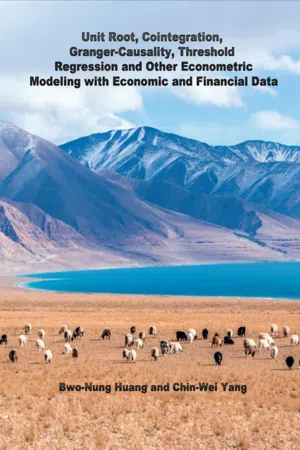
Unit Root, Cointegration, Granger-Causality, Threshold Regression and Other Econometric Modeling with Economics and Financial Data
單根,共積,格蘭傑爾因果,門檻迴歸及其他計量經濟模式
- English
- ePUB (mobile friendly)
- Available on iOS & Android
Unit Root, Cointegration, Granger-Causality, Threshold Regression and Other Econometric Modeling with Economics and Financial Data
單根,共積,格蘭傑爾因果,門檻迴歸及其他計量經濟模式
About this book
Both deductive and inductive methods in scientific research have undergone significant changes since the beginning of the 20th century as sciences advance rapidly.Deductive method reached its pinnacle when Russel's paradox became popular in the field of mathematical logics. The famous barber's paradox illustrates the inevitable logical dilemma: the only barber in an isolated village does the following: (1) he cuts hair for those who do not cut their own and (2) does not cut hair for those who cut their own. Suppose 90 members in the village do not cut their hair (so barber cuts their hair) and 9 cut their own hair (thus barber does not cut their hair). The question is who cuts the barber's hair? The intrinsic contradiction arrives in either way. If barber cuts his own hair, then it contradicts the condition the barber cuts hair for those who do not cut their own hair: the barber cuts his own hair if he (the barber) does not cut his hair. On the other hand, if the barber does not cut his hair, then he (the barber) will cut his own hair, another contradiction.In either case, we seem to arrive at an inescapable contradiction: such a barber cannot possibly exist in the logical world.
Godel took a step further to show contradictions are intrinsically inevitable in his famous Incomplete Theorems.Let us start it by trying to prove the statement that "ghost exists" via valid arithmetic rules and true axioms. Suppose at halfway, we arrive at "that ghost does not exist is provable (which is quite acceptable to some of us)" with all correct logical steps and well-known and time-tested axioms.Assuming for one moment we reject the hypothesis that ghost exists and hence conclude ghost does not exists. The conclusion that "ghost does not exist "can clearly be translated into "that ghost does not exist is provable". However given the hypothesis is false, its proposition logically derived halfway (that ghost does not exist is provable) cannot be true because all the arithmetic rules and axioms are valid. As a result we reject the proposition derived halfway that "ghost does not exist is provable "so that we have "ghost does not exist is not provable or ghost exist is provable" because in a complete system we have only two possible outcomes: either ghost exists or does not exist or it is provable or not provable. In a nutshell, we have arrived at both that "ghost does not exist is provable" and "ghost exists is provable". Reader can find out when the hypothesis is supported, we have two contradictory propositions as well: that "ghost exists is provable" and that "ghost does not exist is provable". There is an intrinsic dilemma between consistency and completeness in the formal deductive logic.
Frequently asked questions
- Essential is ideal for learners and professionals who enjoy exploring a wide range of subjects. Access the Essential Library with 800,000+ trusted titles and best-sellers across business, personal growth, and the humanities. Includes unlimited reading time and Standard Read Aloud voice.
- Complete: Perfect for advanced learners and researchers needing full, unrestricted access. Unlock 1.4M+ books across hundreds of subjects, including academic and specialized titles. The Complete Plan also includes advanced features like Premium Read Aloud and Research Assistant.
Please note we cannot support devices running on iOS 13 and Android 7 or earlier. Learn more about using the app.
Information

Preface I. The Granger Causality Models in Mean and Variance 1. A Bivariate Causality Between Stock Prices and Exchange Rates: Evidence from Recent Asian Flu C.W.J. Granger, Bwo-Nung Huang and Chin-Wei Yang 2. An Analysis of Factors Affecting Price Volatility of the US Oil Market Chin-Wei Yang, Ming J. Hwang and Bwo-Nung Huang 3. Causality and Cointegration of Stock Markets among the US, Japan and South China Growth Triangle Bwo-Nung Huang, Chin-Wei Yang and J.W. Hu 4. Long-run Purchasing Power Parity Revisited : A Monte Carlo Simulation Bwo-Nung Huang and Chin-Wei Yang 5. Oil Price Movements and Stock Market Revisited: A Case of Sector Stock Price Indexes in the G-7 Countries B.J.Lee , Chin-Wei Yang and Bwo-Nung Huang 6. Volatility of Changes in G-5 Exchange Rates and Its Market Transmission Mechanism Bwo-Nung Huang and Chin-Wei Yang 7. Stock Market Integration —An Application of the Stochastic Permanent Breaks Model Bwo-Nung Huang and Robert C.W. Fok 8. State Dependent Correlation and Lead-Lag Relation when Volatility of Markets is Large: Evidence from the US and Asian Emerging Markets Bwo-Nung Huang, Soong-Nark Sohng and Chin-Wei Yang 9. Oil Price Volatility Ming J. Hwang, Chin-Wei Yang , Bwo-Nung Huang and H. Ohta II. Granger Causality Models Using Panel Data 1. Causal Relationship between Energy Consumption and GDP Growth Revisited: A Dynamic Panel Data Approach Bwo-Nung Huang, Ming J. Hwang and Chin-Wei Yang 2. Military Expenditure and Economic Growth across Different Groups: A Dynamic Panel Granger-Causality Approach H. C. Chang, Bwo-Nung Huang and Chin-Wei Yang 3. New Evidence on Demand for Cigarette: A Panel Data Approach Bwo-Nung Huang, Chin-Wei Yang and Ming J. Hwang III. Granger Causality Models with Thresholds 1. Demand for Cigarette Revisited: An Application of the Threshold Regression Model Bwo-Nung Huang and Chin-Wei Yang 2. Does More Energy Consumption Bolster Economic Growth? An Application of Nonlinear Threshold Model Bwo-Nung Huang, Ming J. Hwang and Chin-Wei Yang 3. The Dynamics of a Nonlinear Relationship between Crude Oil Spot and Futures Prices: A Multivariate Threshold Regression Approach Bwo-Nung Huang, Ming J. Hwang and Chin-Wei Yang 4. On the Relationship between Military Expenditure, Threat and Economic Growth: A Nonlinear Approach A.J. Yang, William N. Trumbull, Chin-Wei Yang and Bwo-Nung Huang 5. Factors Affecting an Economy‘s Tolerance and Delay of Response to the Impact of a Positive Oil Price Shock Bwo-Nung Huang 6. Defense Spending and Economic Growth across the Taiwan Strait: A Threshold Regression Model Chung-Nang Lai, Bwo-Nung Huang and Chin-Wei Yang 7. Tourism Development and Economic Growth: A Nonlinear Approach Wan-Chen Po and Bwo-Nung Huang IV. Indirect Granger Causality, Random Walk, Long-term Memory, Volatility of Stock Market and Other Econometric Models
the Multivariate Indirect Causality Model Bwo-Nung Huang and Chin-Wei Yang Bwo-Nung Huang and Chin-Wei Yang the New York Stock Exchange Using Five-Minute Data Bwo-Nung Huang and Chin-Wei Yang Bwo-Nung Huang 5. The Impact of Financial Liberalization on Stock Market Volatility in Emerging Markets Bwo-Nung Huang and Chin-Wei Yang 6. An Analysis of Exchange Rate Linkage Effect: An Application of the Multivariate Correlation Analysis Bwo-Nung Huang and Chin-Wei Yang 7. An Empirical Investigation of Trading Volume and Return Volatility of the Taiwan Stock Market Bwo-Nung Huang and Chin-Wei Yang 8. The Impact of S... |
Table of contents
- 開始